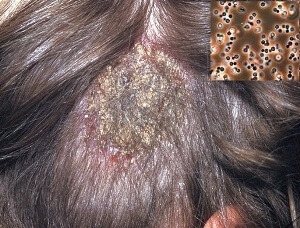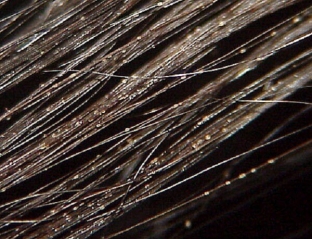The human body – this is a whole planet inhabited by many different inhabitants. Bacteria, viruses, fungi and other microorganisms that inhabit the human body are divided not only into "good" ones; and "evil" ones. Some of them can change their properties depending on the influence of the environment and the state of the organism itself. In any case, infectious diseases that develop in the body under the influence of its "inhabitants" account for a large percentage of all human pathologies. You will be surprised to know that the infection can even affect the hair. About what trichosporia nodosa is, what symptoms it manifests and how this disease is treated, read today at estet-portal.com.
Trichosporia knotty - infectious hair disease
Knotty Trichosporia – This is an infectious disease of the hair, in which nodules of white or black color are formed on the hair cuticle, significantly disrupting the structure of the hair. This pathology most often occurs at a young age and affects, in most cases, female representatives. The disease is chronic and often recurs, so it is necessary to start treatment of this pathology as early as possible.
The main danger of trichosporia nodosum is that this disease is transmitted by contact, which means that all patients require immediate quarantine and complete isolation from other people until complete recovery.
Trichosporia nodosa is not very common in the practice of trichologists, but every specialist should know by what signs this particular pathology can be suspected.
Trichosporia nodosum:
- source of infection: etiology of trichosporia nodosum;
- characteristic clinical picture in trichosporia nodosum;
- basic treatments for trichosporia nodosum.
Source of infection: Trichosporia nodosum etiology
Trichosporia nodosa is an infectious pathology provoked by the activity of pathogenic microorganisms.
 Main source of infection – These are yeast-like fungi. Trichosporon hortai causes a black form of knotty trichosporia, and Trichosporon Beigellii – white. There are also the following factors contributing to the development of the disease:
Main source of infection – These are yeast-like fungi. Trichosporon hortai causes a black form of knotty trichosporia, and Trichosporon Beigellii – white. There are also the following factors contributing to the development of the disease:
- washing hair with contaminated water;
- use of mineral oils and lactic acid products as hair cosmetics;
- violation of the integrity of the hair;
- warm climate;
- aggressive environmental factors.
Characteristic clinical picture in trichosporia nodosum
The clinical picture of trichosporia nodosa depends primarily on the form of pathology. With black trichosporia, the hair on the head is affected, while with white – eyebrows, mustache, beard. Depending on the form of the disease, white or black nodules are formed on the patient's hair, which thin the hair shaft and significantly violate its integrity. The nodules are dense and may merge together to form extensive lesions. A characteristic symptom of trichosporia nodosum – this is a clearly audible crunch when bending and unbending the affected hair bundles, resulting from the destruction of fungal colonies. Another important feature – obvious swelling of the nodules when they are soaked in water.

Basic Treatments for Trichosporia nodosum
Treatment of trichosporia nodosum – this is a rather complicated process, since the disease is chronic, and the main task of the specialist – reduce the number of relapses and maximize the period of remission. As a general drug therapy, the patient is prescribed antifungal drugs, which the trichologist selects individually in each individual case. Vitamin therapy is necessary to strengthen hair weakened by infection and stimulate their growth.
Trichosporia nodosum is treated locally with solutions of salicylic acid or sublimate, which are applied to pre-washed hair, after which they must be combed well with a comb and rinsed again with water.
If the above methods are ineffective, it is necessary to resort to more radical measures – complete shaving of all affected hair.
Dear colleagues! On June 24-26, 2016 Georgia will host the main event of the year in the world of trichology – 17th Congress European Hair Research Society (EHRS 2016).
You will be able to take part in the social program, as well as meet old friends and make new ones. We hope that your participation in this scientific forum will provide a lot of new, professional information.







Add a comment